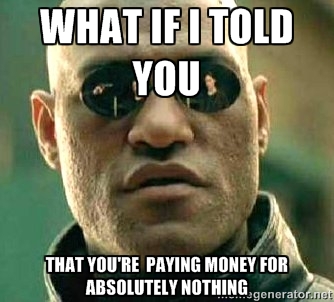[Update, December 8 2014: Google has just put out their own stats, showing that 56% of ads aren’t seen. Nothing new to see here! But please keep wasting your money on CPM ads!]
One of the most ubiquitous metrics in the digital marketing word is the “impression”. The idea is simple—if an ad is shown on a webpage or search engine result, it’s an impression. However, this can give advertisers a false sense of exactly how much their ad has made an impact.
A comScore study in 2013 found that 54% of display ads are never seen. Maybe they were displayed on the page, but they were below the fold, or the person left the page before the ad was fully loaded, or a million of other issues.

This feels like the in-joke of the internet, a wink-wink between traditional agencies and publishers—those that sell display ads to unsuspecting clients and the sites that accept ad revenue.
Both of these parties know that display ad metrics aren’t just inaccurate, they’re a heaping pile of bullshit.
Impressions have ended up being the “look how great we are!” measure that agencies that are more focused on trying to obfuscate what’s really going on so that they look good, rather than report on real results. It’s a big number and it looks amazing to say that your ad had 1 million impressions instead of the sad trombone of 10 clicks. This kind of reporting is particularly rife within so-called “traditional” advertising agencies, who are used to reporting on offline campaigns and are still struggling to understand all this internet stuff.
Impressions are also sacrificed to the altar of vague reporting metrics such as “brand awareness”.
We had a real-life example of this when working with another agency for a mutual client. They claimed that an ad had resulted in “brand awareness” due to the large number of impressions the ad received. But in reality, the creative was boring and blended into the site. There wasn’t even a call to action. Just because your ad had 1,000 impressions, it doesn’t mean that:
- 1,000 more people know about your company.
- 1,000 more people feel good about your company.
- 1,000 people looked at your ad at all.
If you need to measure brand awareness, try measuring it on social media or count people visiting your landing page. Did someone talk about your brand on social? Did they go to your site, maybe sign up for your newsletter? That’s brand awareness! Someone glazing over your display ad on a webpage that they viewed for two seconds isn’t brand awareness.
(Facebook is also guilty of this. The “boost” button on page posts is paying per impressions, although they call it reach. Reach is also a poorly understood metric that’s becoming a stand in for impressions on social media. Buyer beware.)
How did we get here? In the beginning of advertising, we paid per impression. Billboards cost a certain amount depending on how many cars drove by. Nielsen ratings determined how much advertisers should pay for TV shows—sweeps weeks were how television shows inflated their numbers so they could charge more. We didn’t have a better way to measure things.
Then, the internet happened. Instead of thinking “hey, we can measure all kinds of things now!”, pageviews became the default metric of success because it was comfortable and nobody in advertising had to shift too much. You could say “this site gets 10,000 pageviews a day”, put down your client’s money and then tell them that they got 10,000 ad views. Just like buying a radio ad, right?
Pageviews should never have been the default measure of advertising. It’s resulted in awful clickbait headlines (You won’t believe what happens next!) and multipage slideshows (I’m looking at you, Huffington Post). But pageviews are a metric that could be easily measured and sold to people who understood the old school of advertising.
What they didn’t understand (or willfully ignored) was banner blindness. Spend 5 minutes on the internet, and you’ll start to zone out the ads. Some pages make it hard by shouting at you, showing popups, and pushing giant page takeovers, but loud isn’t the new good. You can’t make someone want to pay attention to your creative that was recycled from a billboard.
The internet is not just a cheaper billboard. If your ad isn’t compelling, if it doesn’t speak to me, then you might as well save your money and take yourself out for a nice dinner instead.
The internet, while still a baby, is learning really fast. We can target based on behaviour, what you’re searching for, your age, your Facebook interests, whether or not you already visited our site—a million different ways to show exactly the ad that you’ll be interested in at the moment you see it. But instead, most advertisers submit webpage visitors to the blunt force trauma of multiple ad impressions, hoping for a nice big number they can show on their PowerPoint presentation the next time they’re at a client meeting.
People on the internet aren’t lemmings, just waiting around to be shown something flashy so they can jump off a cliff after it. We all see ads every single day, and we’re smart enough to decide what’s interesting and what’s just more crap to ignore. Recycled creative and scattershot advertising isn’t just lazy, it’s disrespectful to you and to your client. Reporting on impressions reinforces the idea that if you show an ad enough times, we’ll just have to give in to the message. And we all know that isn’t true.



